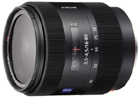Three Carl Zeiss T* Lenses From Sony For The Alpha, And Soon-To-Come Sony D-SLRs; Vario-Sonnar T* DT 16-80mm f/3.5-4.5 ZA Zoom, Planar T* 85mm f/1.4 ZA, And Sonnar T* 135mm f/1.8 ZA Page 2
 |
|
 |
|
 |
|
 |
|
 |
|
|
Carl Zeiss Zoom Lens
Described as a professional-grade model, the Vario-Sonnar T* DT 16-80mm f/3.5-4.5
ZA zoom was designed exclusively for D-SLRs. This 24-120mm equivalent zoom benefits
from a circular aperture, T* coatings, and two glass-molded aspherical elements
with several benefits. They correct spherical aberration (curvature of field)
for more consistent edge-to-edge sharpness even at wide apertures while reducing
comatic flare (blurring near the edges) and linear distortion. This lens is
similar to the primes, but smaller and lighter, with a narrower focus ring and
the addition of a zoom ring. While focusing is internal, the lens does extend
when zoomed, by about 1.75" at the 80mm end.
In spite of the strong family resemblance, this more affordable lens does not
feel quite as rugged as the primes. The barrel includes more parts made of high-grade
polycarbonate materials in order to keep weight at a tolerable level. That's
understandable since this more affordable lens targets a wider range of consumers,
including families who would never want an unusually heavy zoom. Even so, overall
build quality is definitely above average. Mechanically this is a very fine
lens, with tight tolerances; both zooming and manual focus action are stiff
but smooth. Autofocus was also fast and accurate during tests with an A100 camera.
 |
|
|
This zoom turned in performance that justifies its $659 street price, producing
images with remarkably high resolution in the central area even at the maximum
apertures. At those apertures, there's some slight softening near the
borders as well as a bit of shading. Both aspects improve noticeably by f/5.6.
Thanks to the effective lens hood, multilayered T* coating, and internal anti-reflective
strategies, flare is extremely well controlled.
Peak optical performance (incredibly high) was produced in the 18-80mm range,
at f/8, for a level of quality usually expected only from a single focal length
lens. Corner sharpness/brightness is very high, and the images exhibit great
resolution of the most intricate detail, great clarity, snappy contrast, and
a beautiful color rendition. Barrel distortion (bowing outward of lines near
the edges) is obvious at 16mm, decreasing very noticeably at slightly longer
focal lengths. By 24mm, there's virtually no linear distortion. I made
some really stunning 13x19" prints, the largest possible with my Epson
desktop printer; even larger outputs should be equally impressive.
Final Evaluation
As my comments indicated, these ZA-series lenses are certainly worthy of the
blue Zeiss logo. The most affordable of the premium-grade trio, the 16-80mm
Vario-Sonnar T* zoom is also the most desirable in terms of portability and
versatility. It's not built like a high-end Mercedes-Benz but its imaging
performance should be a real eye-opener for anyone who has used only a kit lens
or other inexpensive zoom. This would be a perfect complement particularly for
the 10-megapixel Sony A100 or a future prosumer-level Sony Alpha camera with
even higher resolution.
The 85mm f/1.4 and 135mm f/1.8 Carl Zeiss lenses were intended as problem-solving
tools for those who need a telephoto with the widest possible maximum aperture.
They're professional tools and priced accordingly but this duo should
also attract the most discriminating photo enthusiast. Granted, both command
a premium price but they do pay dividends in terms of superior mechanical, electronic,
and optical features. Try them while visiting a photo retailer and you'll
agree that these robust, beautifully finished lenses hold the potential for
a lifetime of serious photography. Either model should satisfy those who place
a high value on flawless performance, unsurpassed quality, as well as pride
of ownership, prestige, and exclusivity.
Technical Specifications: Carl
Zeiss ZA Lenses |
|||
 |
 |
 |
|
| Lens | Planar T* 85mm f/1.4 ZA | Sonnar T* 135mm f/1.8 ZA | Vario-Sonnar T* DT 16-80mm f/3.5-4.5 ZA |
| Sony Model # | SAL-85F14Z | SAL-135F18Z | SAL-1680Z |
| Angle Of View (Diagonal) | 29Þ (35mm); 19Þ (D-SLR) | 18Þ (35mm); 12Þ (D-SLR) | 83 to 20Þ (D-SLR) |
| Construction | Eight elements in seven groups | 11 elements in eight groups, including two ED | 14 elements in 10 groups, including two aspherical |
| Min. Focus | 2.8 ft | 27" | 13.8" |
| Max. Magnification | 0.13x | 0.25x | 0.24x |
| Filter Size | 72mm | 77mm | 62mm |
| Dimensions (DxL) | 2.8x3.2" | 3.5x4.6" | 2.8x3.4" |
| Weight | 20 oz | 37 oz | 15.5 oz |
| Sony/Maxxum SLR Compatibility | Multi-platform | Multi-platform | Digital only |
| Street Price | $1299 | $1349 | $659 |
For more information, contact Sony Electronics Inc., 16530 Via Esprillo, Ste.
MZ 7104, San Diego, CA 92127; (877)
865-7669; www.sonystyle.com.
A long-time "Shutterbug" contributor, stock photographer Peter K.
Burian (www.peterkburian.com)
is the author of several books, including "Mastering Digital Photography
and Imaging" as well as "Magic Lantern Guides" to the Sony
A100 and Pentax K10D. He is also a digital photography course instructor with
BetterPhoto.com.
- Log in or register to post comments

































